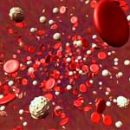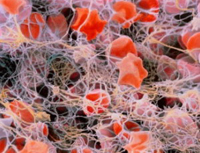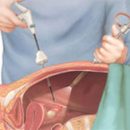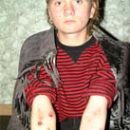Thrombocytopenia - Reducing the number of blood plates in a unit of blood volume. Manifestations of thrombocytopenia - unless bleeding, blood coagulation impairment, etc. Read more in the article.
Content
Thrombocytopenia - a condition characterized by a decrease in the number of platelets below 150 * 10 ^ 9 / l, which is accompanied by increased bleeding and problems with stopping bleeding. How condition may accompany almost any hematological diseases. As an independent disease, diagnosed as an autoimmune (not always) thrombocytopenic purpura or Vergood's disease. The main reasons: violation of platelets and / or increased destruction of platelets. Most often occurs autoimmune thrombocytopenia. Idiopathic is called thrombocytopenia cause of the occurrence of which. Among the possible reasons, epidemiological and infectious: HIV, hepatitis, complications for acute manifestations of herpes infection, infectious mononucleosis, colds, influenza, Goshe's disease. Recently, thrombocytopenia has become a consequence of imported vaccines. In 2008. In Ukraine (g. Kramatorsk) recorded the death case of a 16-year-old schoolboy from Indian measles vaccine and rubella. In addition to him, a few more dozen people ill.
Symptoms of thrombocytopenia
Spontaneous appearance of bruises on the limbs and on the body, a noticeable increase in the time of stopping bleeding. The increase in the nasal bleeding and the appearance of bleeding of mucous mouth. The results of clinical analysis of blood are shown from 0 to 50 * 10 ^ 9. platelets / l under normal range 150-320. Titre on antibodies to platelets can show excess times from the norm 200. The border of hospitalization on different sources below 20 * 10 ^ 9 / l. From 20 to 50 permissible outpatient treatment. Separate sources consider a safe border 30. The general condition, as a rule, does not cause special negative sensations in a patient and is deceptive, since it is fraught with internal bleeding of any organs, as well as hemorrhage to the brain. Categorically contraindicated any physical exertion and it is necessary to limit any vital activity in general.
Treatment of thrombocytopenia
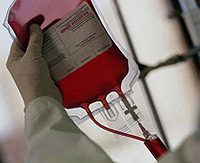 The patient must necessarily pass the hematologist survey. Typically, the reason to identify or fails or the reason as such is no longer any meaning other than the information, since treatment requires either thrombocytopenia itself or a disease that it accompanies. Basic symptomatic treatment - prednisone - hormonal preparation of class steroids with a mass of adverse events. Main - sharp increase in body weight, conclusion of potassium and magnesium, negative impact (before the appearance of hemorrhagic gastritis) on the mucous stomach during oral administration. Basic examination procedures: Full and regular set of blood tests against the background of corticidal taking, including infectious and rheumatological tests, DNA tests and antibodies, ECG, ultrasound, x-ray, endoscopy (by testimony). The basis of clinical treatment in the general case depends on the protocols for the treatment of the underlying disease. For the disease Verlgof, the best result gives the removal of spleen (splenectomy) - according to various sources of up to 80% of success. With the ineffectiveness of splenectomy use chemotherapy Alkaloids Vinca (Vincristin). There are also the protocols of treatment with human immunoglobulins (Hamimun N). Successful statistics are available, but in open access is absent. In some cases, even before the appointment of hormonal drugs, hematologists practiced Plasmapheresis. Results are encouraging.
The patient must necessarily pass the hematologist survey. Typically, the reason to identify or fails or the reason as such is no longer any meaning other than the information, since treatment requires either thrombocytopenia itself or a disease that it accompanies. Basic symptomatic treatment - prednisone - hormonal preparation of class steroids with a mass of adverse events. Main - sharp increase in body weight, conclusion of potassium and magnesium, negative impact (before the appearance of hemorrhagic gastritis) on the mucous stomach during oral administration. Basic examination procedures: Full and regular set of blood tests against the background of corticidal taking, including infectious and rheumatological tests, DNA tests and antibodies, ECG, ultrasound, x-ray, endoscopy (by testimony). The basis of clinical treatment in the general case depends on the protocols for the treatment of the underlying disease. For the disease Verlgof, the best result gives the removal of spleen (splenectomy) - according to various sources of up to 80% of success. With the ineffectiveness of splenectomy use chemotherapy Alkaloids Vinca (Vincristin). There are also the protocols of treatment with human immunoglobulins (Hamimun N). Successful statistics are available, but in open access is absent. In some cases, even before the appointment of hormonal drugs, hematologists practiced Plasmapheresis. Results are encouraging.
The average total time of the survey, making decisions and the possible ending of treatment is 2-6 months without taking into account the subsequent dispensary observation. With the abolition of prednisone, especially after a long course or intramuscular / venical administration, in Tech. from 2-3 days before weeks is observed. N. «Cancellation syndrome»: headaches, tachycardia, high blood pressure, fever, anorexia, sleep disorders both in the direction of drowsiness and insomnia, mental disorders. Symptomatic therapy: but-shpa, valocardine, anesthetics, paracetamol and sleep.

